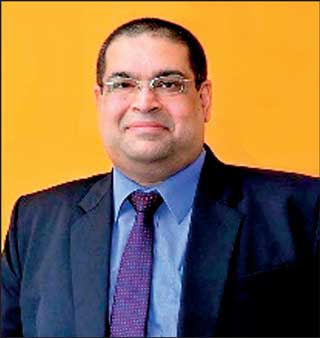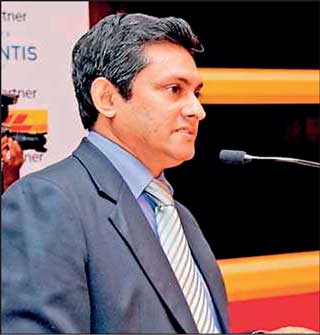Monday Mar 03, 2025
Monday Mar 03, 2025
Monday, 7 February 2022 00:00 - - {{hitsCtrl.values.hits}}
The rubber manufacturing and export industry has shown remarkable growth over both the financial years of 2019 and 2020 and has comfortably crossed the $ 1 billion mark in 2021 surpassing the best performance in 2011.
 |
| Chairman Ravi Dadlani |
 |
| Director General Rohan Masakorala |
Sri Lanka Association of Manufacturers and Exporters of Rubber Products (SLAMERP) Director General Rohan Masakorala said that the year 2021 growth has brought in about a 34% growth compared to 2020, and 20% compared to 2019.
“This shows the sector’s potential to reach much greater heights as both non-pandemic and pandemic eras, the value-added rubber manufacturing and exports have shown credible and stable growth.
SMEs as well as large manufacturers have performed well, specifically in the glove industry and as well as the tyre business has shown remarkable growth with the supplying constraints. If shipping and supply chain constraints were not there, we could have achieved $ 1.3 billion instead of $ 1.1 billion,” Masakorala said.
The Sri Lankan rubber industry has much more potential to export into the world if they can get the necessary environment to continuously expand production.
Masakorala said that the SLAMERP members have continuously put their greatest efforts to increase their annual export targets under challenging circumstances.
He pointed out that the sector depends on a few key elements to increase export revenue, which is the natural rubber production of Sri Lanka, the labour productivity and input energy costs and transaction costs in the supply chain and market access that needs to be addressed to be globally more competitive and diversified.
“Our manufacturers range from domestic entrepreneurs (both large and small) that have mastered technology and put in a lot of sweat to capture the global marketplace. As a result, among buyers, we have gained the name as a ‘trusted quality and a reliable sourcing destination’ for rubber products,” he said.
“With the free economy and an attractive logistics location we have also attracted global top brands for export manufacturing and trading.
We all know that Sri Lanka has been in the rubber industry since the colonial era for well over 140 years and in the past three decades the industry has transformed from a raw material exporter to a much-needed value added export sector through investments. But we have not optimised our potential,” Masakorala added.
SLAMERP Director General also said that if the country had given more focus and implementation of reforms at policy level to the sector, by now Sri Lanka would have probably crossed the $ 3 billion mark.
“However, I’m glad that the rubber master plan, which was launched in 2017, has been accepted by all governments which means if timely, pragmatic decisions are taken we could reach a potential of $ 8 billion, within this decade provided the rubber plantations both small and large are scientifically managed with optimum productivity.
Which means at least doubling the output from 700/800 kg from a hectare to 1,500-1,600 kg in the medium term and focusing towards 2,000 kg by 2024. This is an essential productivity improvement the country needs to embark on,” he said.
“We also need to maximise and increase the current plantations of 120,000-130,000 hectares to 180,000 hectares to increase the natural rubber growing areas to keep phase with demand.
This transformation has been slow, and our message to the Government is to put its fullest effort to achieve these targets. I am confident our exporters will do the rest,” Masakorala said.
On the current economic situation, he then said: “We have already called upon the Government to stabilise the macroeconomic environment and to take the right decisions to come out of the balance of payment crisis which is affecting our supply chains and international marketplace confidence on sourcing from a country where macro-economic signals and the credit ratings are very negative.”
“As an industry we have proposed a 500-acre dedicated production city, but we have not seen the enthusiasm as we wanted from the authorities for the last four years.
If we want FDI and current industrialists to expand, we need these supply chain and trade facilitations along with economic reforms including the labour sector reforms which all industry sectors have been talking about for the last two decades.
Today the business environment is transforming rapidly and COVID-19 has changed many ways that people and markets do business, hence we must adapt to the supply chain realities to be competitive and understand that all businesses need the stable environment to produce, export, and make profits. Otherwise, we will see trade shifts to more attractive locations, we must keep this in mind,” Masakorala added.
In achieving the milestone of $ 1.092 billion of exports for 2021, SLAMERP thanked the Export Development Board, The Board of Investment, relevant line ministries for the support extended over the years and the workforce, the plantations sector and most importantly the entrepreneurs, investors and buyers who have all contributed towards this growth.
“It's time for the Government to take bold decisions as a free economy to expand the market reach and to build investor confidence, exporters are ready to bring in the extra dollars that the country currently needs.
However, while we are celebrating an achievement, we must also caution that to sustain this growth the economic stability of Sri Lanka is critical,” Masakorala added.
Discover Kapruka, the leading online shopping platform in Sri Lanka, where you can conveniently send Gifts and Flowers to your loved ones for any event including Valentine ’s Day. Explore a wide range of popular Shopping Categories on Kapruka, including Toys, Groceries, Electronics, Birthday Cakes, Fruits, Chocolates, Flower Bouquets, Clothing, Watches, Lingerie, Gift Sets and Jewellery. Also if you’re interested in selling with Kapruka, Partner Central by Kapruka is the best solution to start with. Moreover, through Kapruka Global Shop, you can also enjoy the convenience of purchasing products from renowned platforms like Amazon and eBay and have them delivered to Sri Lanka.
Discover Kapruka, the leading online shopping platform in Sri Lanka, where you can conveniently send Gifts and Flowers to your loved ones for any event including Valentine ’s Day. Explore a wide range of popular Shopping Categories on Kapruka, including Toys, Groceries, Electronics, Birthday Cakes, Fruits, Chocolates, Flower Bouquets, Clothing, Watches, Lingerie, Gift Sets and Jewellery. Also if you’re interested in selling with Kapruka, Partner Central by Kapruka is the best solution to start with. Moreover, through Kapruka Global Shop, you can also enjoy the convenience of purchasing products from renowned platforms like Amazon and eBay and have them delivered to Sri Lanka.